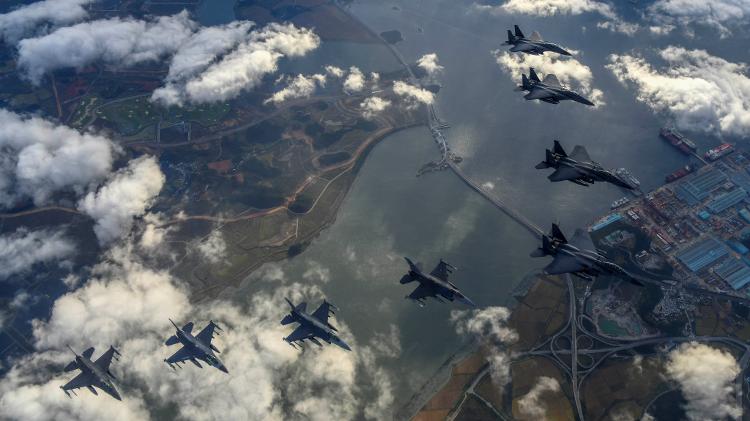South Korea and the United States held joint military exercises after the North Korean missile flew over an area of Japan on Tuesday and continued several military demonstrations by the countries of the region – including joint anti-submarine exercises by the South Korean and US navies on Friday. States and Japan and other North Korean launches.
Today’s North Korean ballistic missile was the first ballistic missile to pass through Japanese soil in the past five years, warning government residents to seek shelter in shelters, resulting in a temporary suspension of train operations in northern Japan.
In contrast, four F-15K teams from the South Korean Air Force and four F-15s from the United States flew in different formations for precision grenade dropping tests, according to South Korean news channel KBS.
“The tests demonstrated the ability of South Korea and the United States to respond to any threat from North Korea,” the newspaper said, citing a statement from the South Korean military. South Korea’s Ministry of Defense released photos of the jets during the exercises.
Analysts told Reuters they see the increased testing pace as an effort to build operational weapons, as well as an effort to capitalize on a world distracted by the conflict and other crises in Ukraine by making testing “normalised.”
Rival Koreas are in a regional arms race, which has seen a huge increase in arms and military spending. In addition, South Korean officials said that North Korea has completed preparations for what will be its seventh nuclear test since 2006 and its first since 2017.
South Korea has recently sought a non-proliferation agreement with the northern country, an offer of economic aid by Seoul in exchange for denuclearization of the communist country, which was rejected by Kim Jong-Un’s government.
In early September, North Korea passed a law that formally protects its nuclear weapons policies, in a move that Kim Jong Un says makes its nuclear status “irreversible” and hinders denuclearization talks.
The US presence also encourages them to try a military show of force. On September 23, a US aircraft carrier docked in South Korea for the first time in nearly five years. The USS Ronald Reagan is classified as a “fight-ready force” on the US Navy website.
In August, USS Ronald Reagan crossed the South China Sea to reach the Philippine Sea, east of Taiwan, the Philippines, and south of Japan. The statement came during a visit to Taiwan by Nancy Pelosi, Speaker of the US House of Representatives.
The fifth missile was launched within two weeks. Last week, North Korea had already fired four more ballistic missiles. Two of these were launched hours before South Korea held a major military demonstration showcasing its stealth fighter jets and its own missiles.
US Vice President Kamala Harris was in the area the day before the third launch and met with South Korean President Yoon Suk-yeol. She visited the demilitarized zone on the northern border as part of her trip to strengthen her security alliance with Seoul.
“They condemned the DPRK’s (Democratic People’s Republic of Korea) provocative nuclear rhetoric and ballistic missile launches,” the White House said in a statement. “They discussed our response to possible future provocations, including tripartite cooperation with Japan.”
Before his visit, Harris condemned the ballistic launches and described North Korea as a “brutal dictatorship”:
“We see a brutal dictatorship in the North, widespread human rights abuses and an illegal weapons program that threatens peace and stability,” he said. “The United States and the world seek a stable and peaceful Korean Peninsula where North Korea is no longer a threat.”
Residents of the Japanese area were warned to evacuate because of the missile hazard. Today’s launch was an intermediate-range ballistic missile (IRBM) launched from North Korea’s Jagang Province. This province has been used to launch several tests recently, including several missiles that the North Koreans claim are “hypsonic”.
The Japanese government warned citizens to protect themselves as the missile flew past its territory before hitting the Pacific Ocean. Japan said it did not use any defensive measures to destroy the missile.
“North Korea’s series of actions, including repeated ballistic missile launches, threatens the peace and security of Japan, the region and the international community, and poses a serious threat to the entire international community, including Japan,” a Japanese government spokesman said. . , Hirokazu matsunoat a press conference.
Speaking to reporters a short time later, the Prime Minister said, To smoke per person so-called actions of Korea North He made a statement regarding the “barbarians” and stated that the government will continue to collect and analyze information.
The United States and Europe condemned North Korea’s latest action. US Indo-Pacific Command condemned the North Korean launch and reaffirmed its commitment to the defense of Japan and South Korea.
Prior to testing with the South Koreans, the White House announced that US National Security Advisor Jack Sullivan spoke with South Korean and Japanese officials to devise an “appropriate and robust international response.”
European Council President Charles Michel described the attack as “unjustified aggression” and said the European Union “stands in solidarity with Japan and South Korea”. According to him, this is a “deliberate attempt” to undermine security in the region.
*With information from Reuters
source: Noticias
